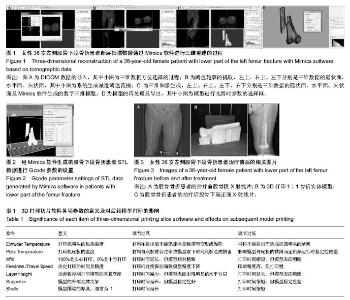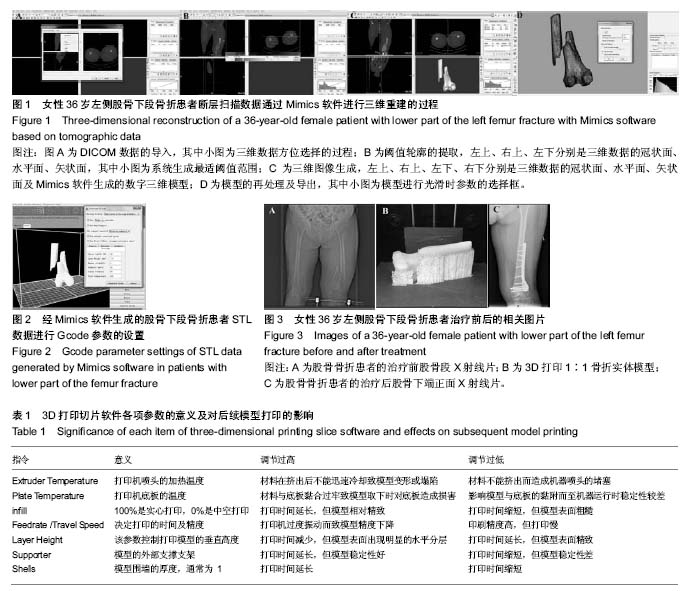| [1] Gardner MJ,Schmidt AH. Tibial plateau fractures. J Knee Surg. 2014;27(1):3.[2] Marro A, Bandukwala T, Mak W. Three-dimensional printing and medical imaging: a review of the methods and applications. Curr Probl Diagn Radiol. 2016;45(1):2-9.[3] Malik HH, Darwood AR, Shaunak S, et al. Three-dimensional printing in surgery: a review of current surgical applications. J Surg Res. 2015;199(2):512-522.[4] Zielinski SM, Bouwmans CA, Heetveld MJ, et al. The societal costs of femoral neck fracture patients treated with internal fixation. Osteoporos Int. 2014;25(3):875-885.[5] Guarino J, Tennyson S, McCain G, et al. Rapid prototyping technology for surgeries of the pediatric spine and pelvis: benefits analysis. J Pediatr Orthop. 2007;27(8): 955-960.[6] Lim SH, Kim MK, Kang SH. Genioplasty using a simple CAD/CAM (computer-aided design and computer-aided manufacturing) surgical guide. Maxillofac Plast Reconstr Surg. 2015;37(1):44.[7] 杨龙,王建吉,孙琦,等.胫骨平台骨折植入物内固定修复中3D打印技术的辅助应用[J].中国组织工程研究,2016,20(13):1904-1910.[8] Naftulin JS, Kimchi EY, Cash SS. Streamlined, Inexpensive 3D Printing of the Brain and Skull. PLoS One. 2015;10(8): e0136198.[9] Li J, Zhang H, Yin P, et al. A new measurement technique of the characteristics of nutrient artery canals in tibias using materialise's interactive medical image control system software. Biomed Res Int. 2015;2015:171672.[10] You W, Liu LJ, Chen HX, et al. Application of 3D printing technology on the treatment of complex proximal humeral fractures (Neer3-part and 4-part) in old people. Orthop Traumatol Surg Res. 2016;102(7):897-903.[11] Liu P, Liu R, Zhang Y, et al. The value of 3D printing models of left atrial appendage using real-time 3d transesophageal echocardiographic data in left atrial appendage occlusion: applications toward an era of truly personalized medicine. Cardiology. 2016;135(4):255-261.[12] 阮征,王永武,陈勇,等.基于Geomagic Qualify检测和提高激光快速成型法制造肋骨实体的精确度[J].外科研究与新技术,2014, 3(2):108-114.[13] 王爱国,谷福顺,郑昆仑,等.单臂外固定架固定股骨粗隆间骨折肌骨三维有限元模型的建立[J].中国中西医结合外科杂志,2015, 21(6):592-596.[14] Govsa F, Yagdi T, Ozer MA, et al. Building 3D anatomical model of coiling of the internal carotid artery derived from CT angiographic data. Eur Arch Otorhinolaryngol. 2016.[15] Ibrahim D, Broilo TL, Heitz C, et al. Dimensional error of selective laser sintering, three-dimensional printing and PolyJet models in the reproduction of mandibular anatomy. J Craniomaxillofac Surg. 2009;37(3):167-173.[16] Silva DN, de Oliveira M G, Meurer E, et al. Dimensional error in selective laser sintering and 3D-printing of models for craniomaxillary anatomy reconstruction. J Craniomaxillofac Surg. 2008;36(8):443-449.[17] Fitzwater KL, Marcellin-Little DJ, Harrysson OL, et al. Evaluation of the effect of computed tomography scan protocols and freeform fabrication methods on bone biomodel accuracy. Am J Vet Res. 2011;72(9):1178-1185.[18] Castilho M, Dias M, Gbureck U, et al. Fabrication of computationally designed scaffolds by low temperature 3D printing. Biofabrication. 2013;5(3):035012.[19] Bian W, Li D, Lian Q, et al. Design and fabrication of a novel porous implant with pre-set channels based on ceramic stereolithography for vascular implantation. Biofabrication. 2011;3(3):034103.[20] Duan B, Wang M, Zhou WY, et al. Three-dimensional nanocomposite scaffolds fabricated via selective laser sintering for bone tissue engineering. Acta Biomater. 2010; 6(12):4495-4505.[21] Wu C, Luo Y, Cuniberti G, et al. Three-dimensional printing of hierarchical and tough mesoporous bioactive glass scaffolds with a controllable pore architecture, excellent mechanical strength and mineralization ability. Acta Biomater. 2011;7(6): 2644-2650.[22] Wang H, Zhao B, Liu C, et al. A comparison of biocompatibility of a titanium alloy fabricated by electron beam melting and selective laser melting. PLoS One. 2016;11(7):e0158513.[23] Rasooly A, Bruck HA, Kostov Y. An ELISA Lab-on-a-Chip (ELISA-LOC). Methods Mol Biol. 2013;949:451-471.[24] Chae MP, Rozen WM, McMenamin PG, et al. Emerging applications of bedside 3d printing in plastic surgery. Front Surg. 2015;2:25.[25] Tam MD, Laycock SD, Bell D, et al. 3-D printout of a DICOM file to aid surgical planning in a 6 year old patient with a large scapular osteochondroma complicating congenital diaphyseal aclasia. J Radiol Case Rep. 2012;6(1):31-37.[26] Rankin TM, Giovinco NA, Cucher DJ, et al. Three-dimensional printing surgical instruments: are we there yet. J Surg Res. 2014;189(2):193-197.[27] Davidovitch RI, Weil Y, Karia R, et al. Intraoperative syndesmotic reduction: three-dimensional versus standard fluoroscopic imaging. J Bone Joint Surg Am. 2013;95(20): 1838-1843.[28] Brunner A, Heeren N, Albrecht F, et al. Effect of three-dimensional computed tomography reconstructions on reliability. Foot Ankle Int. 2012;33(9):727-733.[29] Brunner A, Heeren N, Albrecht F, et al. Effect of three-dimensional computed tomography reconstructions on reliability. Foot Ankle Int. 2012;33(9):727-733.[30] 裴国献.3D打印技术:骨科最新冲击波[J].中华创伤骨科杂志, 2015,17(1):8-9.[31] Yang L, Shang XW, Fan JN, et al. Application of 3D Printing in the Surgical Planning of Trimalleolar Fracture and Doctor-Patient Communication. Biomed Res Int. 2016;2016: 2482086. |

